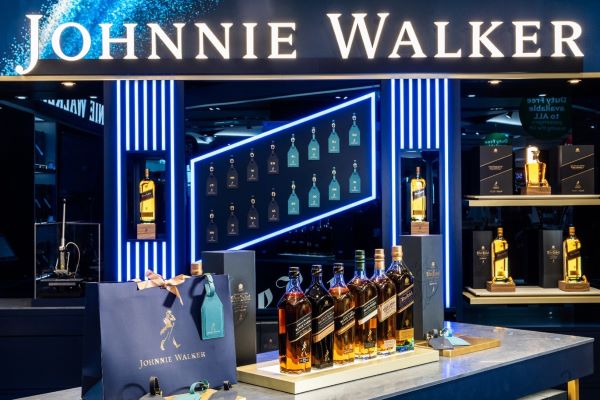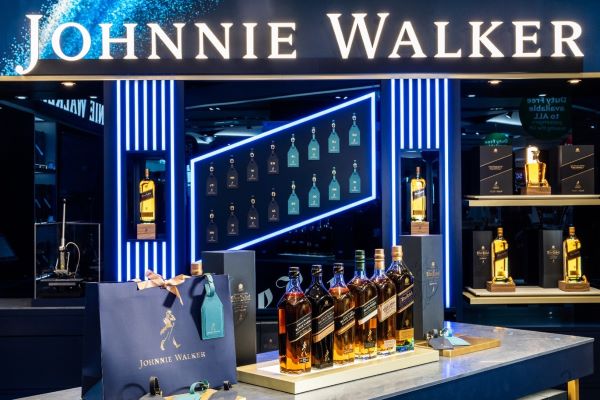Have you ever had it Blue?
With a little help from Covid which grounded foreign travel and closed fancy restaurants, Diageo surfed the wave of premiumisation with Johnnie Walker Blue. Tom Bruce-Gardyne delves behind the label and ponders the future for this ultimate luxury brand …
In 2020 Diageo released possibly the most lavish brand film ever produced – a feature-length tribute to its blue-eyed boy – Johnnie Walker. The film was to celebrate the brand's 200th anniversary, and opens with aerial footage of a bombed-out Iraq. A former US intelligence officer explains how he spent five years "reconciling bad actors" with the help of whisky. "But in Baghdad," he says in his gravelly voice, "it had to be Johnnie Walker Blue."
'Expensive tastes' you might say, for this consummate deluxe blend currently costs £174 at the Whisky Exchange. With its message to 'Keep Walking', Johnnie Walker is all about progression from Red to Black to Blue. The latter appears in films as a short-hand for wealth and status, just like a character ordering Dom Perignon champagne or flashing a Rolex watch.

In 'American Fiction', the brilliant, recently released, satire about a black, middle-class novelist called Monk whose books are considered insufficiently 'black', the brand is given an entire scene. Arthur, his agent, plonks three bottles on his desk, and declares: "Johnnie Walker Red - 24 bucks, Johnnie Walker Black - 50 bucks, Johnnie Walker Blue - 160 dollars."
"They are all made by the same company. The Red is shit. The Black is less shit, but the Blue is good," he says. "Few people buy the Blue because it's expensive and, at the end of the day, most people just want to get drunk." It is the film's central metaphor – that Monk is up at the 'blue' level, but that doesn't stop him writing a 'red' book.
Whether Diageo would employ Arthur as a salesman is debatable. He would have to drop the expletives and any mention of intoxication – a complete no-no in this age of 'responsible drinking', but at least he gets the 'good-better-best' dynamic that powers the brand.

Blue Label was a relative late-comer, born in 1987 and originally called Johnnie Walker Oldest. Its principal architect was the late Tom Jago, a marketing guru whose credits include Bailey's and Malibu, according to the whisky writer Nick Morgan who worked for Diageo and penned the official history of Johnnie Walker – 'A Long Stride' in 2020.
Of Blue Label, he wrote - 'Proudly bearing the words attributed to Alexander Walker, 'Our blend cannot be beat', and with a bottle that harked back to the late nineteenth century, this new brand represented a step change in whisky packaging and marketing.' He believes the fact it was launched just after the Guinness take-over of the Distillers Co, as were the Classic Malts, was no coincidence. It was a way of showing City investors that things had changed.
Another reason for its launch was "to reassert the perceived value of the Johnnie Walker brand in Asia where grey market discounting had damaged it" according to an obituary of Tom Jago who died in 2018. There were other high-end blends like Royal Salute 21 year-old that had been around since 1953, but Blue Label was always a bit different.
It's original mention of age – 'Aged 15 to 60 years' was quickly dropped, and its owners have always been vague about its contents. Jennifer English, Johnnie Walker's global brand director repeats the well-worn line that "only one in 10,000 casks possess the precise quality and character we are looking for to create this luxury blend," and mentions a few distilleries. Among them; Cardhu, Clynelish, Caol Ila and the closed grain distillery of Port Dundas, and Port Ellen which was shut for forty years until it reopened this year.
"Time is the most valuable asset of all," she continues, referring to the time taken by the 12-strong blending team in selecting the casks, and the time maturing in wood which has earned the brand its claim to be 'the rarest of the rare'. Being in almost every top-end bar, store and duty-free outlet means it's not that rare in the market, but then neither is that other luxury icon – Dom Perignon whose sales are estimated at over 5 million bottles a year.
In 'A Long Stride' we learn that 'By 1997 Blue Label was selling almost 50,000 highly profitable cases.' It came to symbolise premiumisation with the late Sir Ivan Menezes announcing its net sales were up 60% in Diageo's full-year results in July 2022, compared to 40% growth in Black Label and 20% in Red Label. In the US, one of its top three markets alongside travel retail and Greater China, wealthy consumers gorged on Blue Label during lockdowns and continued drinking it as Covid receded.
And this despite the huge trade-up from Black Label. There are price points in between like Green Label and the 18 year-old as Jennifer English points out, but it's Johnnie Walker Blue that people aspire to. At a recent 'Whisky Live' in Johannesburg Nick Morgan was struck by the queue of what he calls "South Africa's new middle class" waiting to enter the 'Blue Label Experience'

"It was obviously such an aspirational thing for people who wanted to feel they'd arrived somewhere," he says. "And I think, whether by luck or good judgement it has that reputation all around the world." In the US it "became one of the fastest-growing brands," where consumers "spent nearly a third more on spirits in 2022 that they did pre-pandemic," claimed Brooke Masters in the FT last October.
But as she concluded: "As drinks makers partied hard, they forgot the simple rule that all things — even boozy nights out — come to an end." That seems true in America right now, yet Blue Label has bounced back in travel retail and it is doing well in pockets in Asia, notably South Korea.
One can only guess how much profit each bottle sold generates, but it helps oil the supply chain and fund opulent campaigns – not least the Gentleman's Wager – the two films starring Jude Law and Giancarlo Giannini of ten years ago. Since then, the marketing has shifted "to focus on liquid innovation and cultural collaborations," says Jennifer, who mentions the latest innovation - Blue Label Ultra that comes in the world's lightest whisky glass bottle. It's as light as an iPhone and just £1,000 a pop.

Nick Morgan dates the Johnnie Walker brand as starting in 1908 with the Striding Man and says: "Blue Label is the prize you get for about 120 years of being remorseless in driving your brand." In Baghdad, they'd drink to that.

Award-winning drinks columnist and author Tom Bruce-Gardyne began his career in the wine trade, managing exports for a major Sicilian producer. Now freelance for 20 years, Tom has been a weekly columnist for The Herald and his books include The Scotch Whisky Book and most recently Scotch Whisky Treasures.
You can read more comment and analysis on the Scotch whisky industry by clicking on Whisky News.
